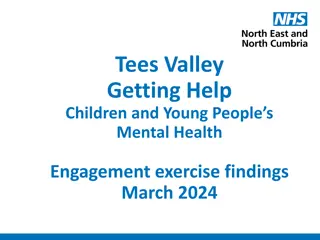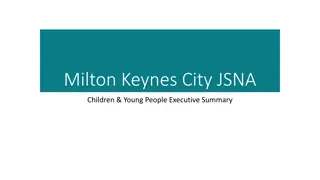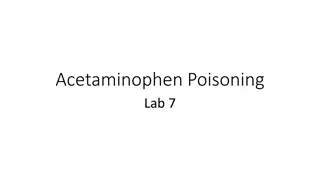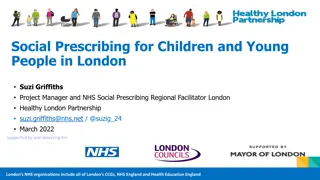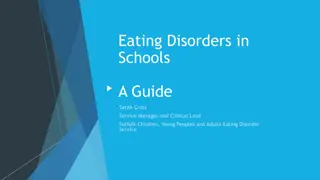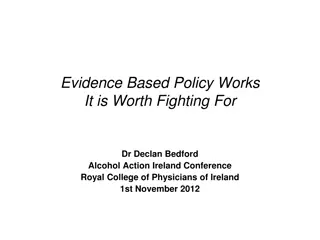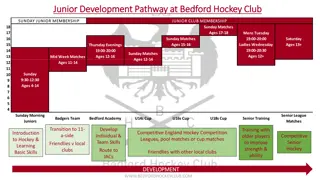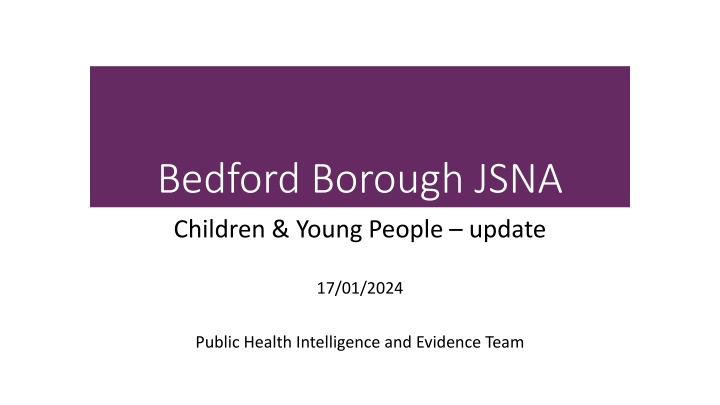
Insights on Healthy Pregnancy and Early Years in Bedford Borough
Discover key insights on healthy pregnancy and early years in Bedford Borough, including factors impacting health outcomes, priorities for COVID-19 recovery, and statistics on infant health indicators. Explore the importance of promoting early access to maternity care, embedding a whole family approach, and monitoring smoking in pregnancy for improved community well-being.
Download Presentation

Please find below an Image/Link to download the presentation.
The content on the website is provided AS IS for your information and personal use only. It may not be sold, licensed, or shared on other websites without obtaining consent from the author. If you encounter any issues during the download, it is possible that the publisher has removed the file from their server.
You are allowed to download the files provided on this website for personal or commercial use, subject to the condition that they are used lawfully. All files are the property of their respective owners.
The content on the website is provided AS IS for your information and personal use only. It may not be sold, licensed, or shared on other websites without obtaining consent from the author.
E N D
Presentation Transcript
Bedford Borough JSNA Children & Young People update 17/01/2024 Public Health Intelligence and Evidence Team
Bedford Borough Healthy Pregnancy Snapshot (2023) Risk factor indicators Health outcome indicators Smoking is the biggest single factor that negatively impacts health in pregnancy. Fewer women in Bedford Borough are known to be smoking at the time of delivery than the average for the deprivation decile. Infant mortality rate is higher in Bedford compared to the deprivation decile (and has increased slightly), but this difference is not statistically significant. Teenage parenting increases the risk of poorer health outcomes without additional support. The rate of teenage pregnancy is slightly lower in Bedford Borough than the national average. Fewer than 80 births per 1,000 are premature, below the average of similar local authorities based on deprivation. The percentage of babies with a low birth weight in Bedford is in line with the average for England, but with significant variations, with Elstow and Stewartby much worse and Harold much better. Early access to maternity services improves birth outcomes. Over 3/4 of pregnant women accessed maternity care early in Bedford - significantly better than local authorities of similar deprivation. Obesity during pregnancy increases the health risks for both the mother and child. Over 1/2 of female adults in Bedford Borough are classified as About 1 in 5 women nationally are affected by perinatal mental health issues. overweight or obese.
Healthy Pregnancy Priorities COVID-19 recovery Priority areas 1. Promote early access to maternity care. Development of Community Maternity Hubs 2. Embed a whole family approach. Antenatal and postnatal care 3. Co-produce local maternity services. Continuity of care Priority actions 1. Roll-out Continuity of Carer . 2. Women and partners are listened to and heard. 3. Improved information sharing between maternity and health visiting services. 4. Efficient mental health referral system. 5. Monitor smoking in pregnancy. Keeping Well in Pregnancy team. 6. Review Maternity Obesity Pathway.
Bedford Borough Healthy Birth and Early Years Snapshot (2023) Risk factor indicators Health outcome indicators Breast feeding is linked to lower the rates of gastroenteritis, respiratory infections, sudden infant death syndrome, obesity and allergies. The proportion of women breastfeeding at initiation is slightly down from previous years but at 6-8 weeks hasimproved. These are both significantly better than the national average. The rate of A&E attendances in children aged 0-4 years has increased from the previous year but remains significantly lower than local authorities in the same deprivation decile. Vaccination is recognised as one of the most effective public health interventions in the world. The percentage of infants who received two doses of MMR vaccine has increased from previous levels and is better than the national average. The rate of admissions for lower respiratory tract infections in infants under the age of 1 year has decreased and is significantly better than local authorities in the same deprivation decile. Admissions for gastroenteritis in 1-year-olds increased dramatically and is now significantly higher than local authorities in the same deprivation decile. Poor oral health can affect a child s ability to speak, eat, sleep, play, socialise, and can negatively impact on their school attendance and wellbeing. Over 1/5 of 5-year-olds exhibit visually obvious tooth decay. This is improving and is better than the national average. The proportion of 5 year olds reaching a good level of development at the Early Years Foundation stage decreased slightly andis worse thanlocal authorities in the same deprivation decile. Adverse Childhood Experiences or traumatic events, such as domestic abuse increase the risk of high-risk behaviours and poorer outcomes as adults. The rate of domestic abuse incidents per 1,000 slightly reduced and is in line with the national average.
Healthy Birth and Early Years Priorities COVID-19 recovery Priority areas 1. Develop and retain integrated workforce. 0-5 services continuing to re-engage families as well 2. Train all professionals working with children and families. as support healthy births and child development. 3. Support parents and carers in preparation for education. Face to face delivery of services alongside virtual 4. Promote responsive breastfeeding, responsive bottle-feeding and smoke-free environments. support where proven effective. 5. Reduce unintentional injuries. Workforce recruitment remains challenging. Priority actions 1. Vaccination delivery and monitor activity. 2. Improve immunisation rates through communication, co-ordination improvements and promotion. 3. Support access to community vaccination venues. 4. Improve response for vulnerable children.
Bedford Borough School-aged Years Snapshot (2023) Risk factor indicators Outcome indicators Compared to local authorities in the same deprivation decile and/or national average, hospital admissions due to: Obese children have a higher risk of poor health, disability and premature mortality in adulthood and potentially poorer teenage mental health. Roughly 1 in 5 Reception children are overweight or obese, this has improvedand is significantly better than the national average. At Year 6 that proportion stays in line with the national average, which increased to around 36%. Self-harm in young people aged 10 to 24 years reduced and remains better. Mental health conditions for those aged 0 to 17 increased Alcohol-specific conditions for those under 18 decreasedand remains better. Substance misuse for those aged 15 to 24 decreased Unintentional and deliberate injuries in those under 14, increased slightly Asthma for those under 18 increased andis now worse. Children suffering from poor mental ill health are at risk of poor physical health outcomes, poor educational attainment, and are at greater risk of unhealthy behaviours. A lower number of school pupils in Bedford Borough have social, emotional and mental health needs than the average for the deprivation decile. The average Attainment 8score at 15-16 years old continued to decreaseand remains significantly worse than the deprivation decile average. Smoking is a major cause of ill health, particularly heart and lung disease and many people who start smoking as adolescents continue to smoke into adulthood. The prevalence of smokers in Bedford Borough s children under the age of 15 is above the national average.
School-aged Years Priorities Priority areas COVID-19 recovery 1. Support education settings to provide information and curriculum in regards to good health, wellbeing and resilience. Services changing the response to different needs and additional demands. 2. Access to services that develop healthy behaviours. Commissioners and services to work more 3. Strengthen support regarding mental health. closely together to ensure effective early 4. Create communities with environment focus. support. 5. Effective contraception and sexual health services. 6. Safe at home and in community services. Priority actions 1. Effectively communicate details of all services available. 2. Effectively address excess weight. 3. Act on the voice and experience of all young people. 4. Response to impact of adverse experiences, trauma and contextual safeguarding.




